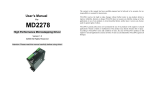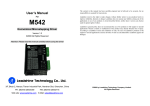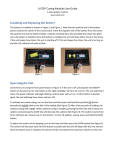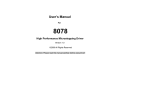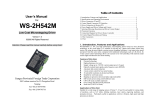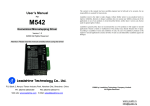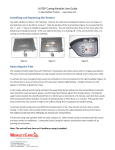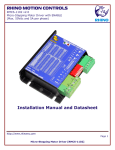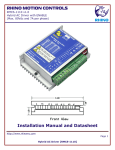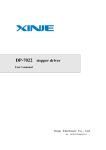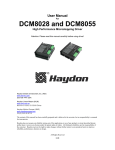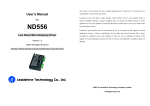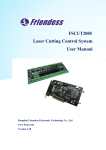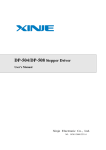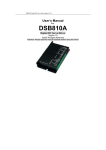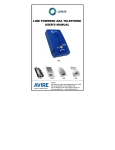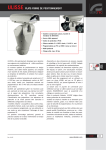Download High Performance Microstepping Driver
Transcript
User’s Manual For 5056 High Performance Microstepping Driver Version 1.0 ©2000 All Rights Reserved Attention: Please read this manual carefully before using driver! 5056 5056 High Performance Microstepping Driver V1.0 Table of Contents High Performance Microstepping Driver V1.0 of machines, such as X-Y tables, labeling machines, laser cutters, engraving machines, and pick-place devices. Particularly useful in applications with extremely low noise and low vibration, high speed and high precision are desired. 1. Introduction, Features and Applications ···································································2 2. Specifications and Operating Environment ······························································3 3. Driver Connectors P1 and P2 ···················································································4 4. Control Signal Connector (P1) Interface ····································································5 5. Driver Connection to Motors (P2) ············································································6 6. Power Supply and Driver Voltage and Current ···························································9 7. Selecting Microstep Resolution and Driver Current Output········································11 8. Protection Functions ··································································································12 9. Connection Diagram for Driver, Motor, Controller ····················································13 10. Control Signal Waveform and Timing ······································································13 11. Wire Connection ······································································································14 12. FAQ·························································································································14 Appendix: Limited Warranty ·························································································16 2. Specifications and Operating Environment Electric Specifications (Tj = 25℃) 5056 1. Introduction, Features and Applications Parameters Min Typical Max Unit Output Current 1.4 (RMS1.0A) - 5.6 (RMS4.0A) Amps Supply voltage (DC) 20 36 50 VDC Logic signal current 7 10 16 mA Pulse input frequency 0 - 400 Isolation resistance 500 Khz MΩ Operating Environment and Parameters 5056 is a high performance microstepping driver using precise sine wave current control technology, it is particular suitable for applications desired with extremely low noise and low heating. Currently most of the microstepping driver in the market apply “mock-sine” current control technology, which makes the output current to be distorted sine wave, or makes much current ripple, both cause the motor higher noise and bigger vibration, furthermore cause serious motor heating, so when the motor works long time, the torque decrease, motor aging and the use life shorted. However the pure-sine precise current control technology (domestic patented technology) applied by 5056 can improve above pr oblems very well, and the operating effect of the stepping motor is somehow inclined to that of servo motor. Features of this driver Patented technology Pure-sine precise current control technology Extreme low motor noise Both driver and motor low heating High performance, low cost Supply voltage up to +50VDC, current output up to 5.6A peak (RMS4.0A) Optically isolated differential input signals, pulse frequency up to 400 KHz Automatic idle-current reduction 16 selectable resolutions in decimal and binary Suitable for 4,6,8 lead motors DIP switch current setting with 8 different value Over-voltage and short-circuit protection Small size (118x75.5x33mm) Cooling Natural cooling or forced convection Environment Space Avoid dust, oil frost and corrosive gas Temperature 0°- 50℃ Humidity 40 - 90%RH Vibration 5.9m/s Max Storge Temp. 2 -20℃ - 125℃ Weight Approx. 280 gram (9.9 oz) Mechanical Dimensions (unit:mm, 1 inch = 25.4 mm) Front View Side View Figure 1: Mechanical dimensions Applications of this driver Suitable for a wide range of stepping motors of Nema 17, 23 and 34, and usable for various kinds 2 *Recommended to use side mounting for better heat dissipation 3 5056 5056 High Performance Microstepping Driver V1.0 High Performance Microstepping Driver V1.0 4. Control Signal Connector (P1) Interface Extra Heat Sink Driver’s reliable working temperature should be <65℃, motor temperature <80℃; It is recommended automatic half-current mode, i.e. current automatically reduced by 60% when motor stops, so as to decrease driver and motor’s heating; Please mount the driver vertically to maximize heat sink area. This driver uses differential inputs to increase noise immunity and interface flexibility. Single-ended control signals from the indexer/controller can also be accepted by this interface. The input circuit has built-in high-speed opto -coupler, and can accept signals in the format of line driver, open-collector, or PNP output. Line driver (differential) signals are suggested for reliability. In the following figures, connections to open-collector and PNP signals are illustrated. Open-collector (common-anode) D r i v e r 3. Driver Connectors, P1 and P2 VCC PUL+ PUL R DIR R ENA R The driver has two connectors, P1 for control signals, and P2 for power and motor connections. PULDIR+ The following is a brief description of the two connectors of the driver. More detailed descriptions of the pins and related issues are presented in section 4, 5, 6, 9. 270Ω DIR- ENA+ Control Signal Connector P1-pins Signal Functions PUL﹢(+5V) Pulse signal: in single pulse(pulse/direction) mode, this input represents pulse signal, effective for each upward – rising edge; 4-5V when PULPUL- (PUL) HIGH, 0-0.5V when LOW. For reliable response, pulse width should be longer than 1.2µs. Series connect resistance for current-limiting when +12V or +24V used. DIR+ (+5V) Direction signal: HIGH/LOW level signal, corresponding to motor rotor direction. For reliable response, DIR must be ahead of PUL by 5µs at least, the initial motor direction is related with motor wiring, DIR- (DIR) exchange any set of coil can reverse motor initial direction. 4-5V when DIR- HIGH, 0-0.5V when LOW. Enable signal: this signal is used for enable/disable, high level for ENA+ (+5V) enabling driver and low level for disabling driver. Usually left ENA- (ENA) unconnected(enabled). Remark : Please note motion direction is also related to motor-driver wiring match. Exchanging the connection of two wires for a coil to the driver will reverse motion direction. (for example, reconnecting motor A+ to driver A- and motor A- to driver A+ will invert motion direction). 270 Ω 270Ω ENA- R=0 if VCC=5V; R= 1K if VCC=12V ; R=2K if V CC=24V; R must be connected to control si gnal terminal. Figure: 2 signal interface (common-anode) PNP output (common-cathode) D r i v e r VCC PUL+ PUL R DIR R ENA R 270Ω PULDIR+ 270Ω DIR- ENA+ 270Ω ENA- Power connector P2 pins Pin No. Signal Functions 1 Gnd DC power ground 2 +V DC power supply, +20VDC - +50VDC, Including voltage fluctuation and EMF voltage. 3, 4 Phase A Motor coil A (leads A+ and A-) 5, 6 Phase B Motor coil B (leads B+ and B-) R=0 if VCC=5V; R=1K if VCC=12V; R=2K if VCC=24V; R must be connected to control signal terminal. Figure 3: signal interface (common-anode) 4 5 5056 5056 High Performance Microstepping Driver V1.0 High Performance Microstepping Driver V1.0 5. Driver Connection to Step Motors 5056 driver can drive any 4, 6, 8 lead hybrid connection to various kinds of motor leads: step motors. The following diagrams illustrate Parallel Connection An 8 lead motor in a parallel configuration offers a more stable, but lower torque at lower speeds. But because of the lower inductance, there will be higher torque at higher speeds. Multiply the per phase (or unipolar) current rating by 1.96, or the bipolar current rating by 1.4, to determine the peak output current. Figure 6: 8 Lead Motor Parallel Connections Figure 4: Driver Connection to Step Motor Note that when two coils are parallelly connected, coil inductance is reduced by half and motor speed can be significantly increased. Serial connection will lead to increased inductance and thus the motor can be run well only at lower speeds. 5.1 Connecting to 8-Lead Motors 8 lead motors offer a high degree of flexibility to the system designer in that they may be connected in series or parallel, thus satisfying a wide range of applications. Series Connection A series motor configuration would typically be used in applications where a higher torque at lower speeds is required. Because this configuration has the most inductance, the performance will start to degrade at higher speeds. Use the per phase (or unipolar) current rating as the peak output current, or multiply the bipolar current rating by 1.4 to determine the peak output current. 5.2 Connection to 6-Lead Motors Like 8 lead stepping motors, 6 lead motors have two configurations available for high speed or high torque operation. The higher speed configuration, or half coil, is so described because it uses one half of the motor’s inductor windings. The higher torque configuration, or full coil, use the full windings of the phases. Half Coil Configuration As previously stated, the half coil configuration uses 50% of the motor phase windings. This gives lower inductance, hence, lower torque output. Like the parallel connection of 8 lead motor, the torque output will be more stable at higher speeds. This confi8guration is also referred to as bal copper. In setting the driver output current multiply the specified per phase (or unipolar) current rating by 1.4 to determine the peak output current. Figure 5: 8 Lead Motor Series Connections 6 7 5056 5056 High Performance Microstepping Driver V1.0 High Performance Microstepping Driver V1.0 Figure 9: 4 Lead Motor Connections Figure 7: 6 Lead Half Coil (Higher Speed) Motor Connections Full Coil Confuguration The full coil configuration on a six lead motor should be used in applications where higher torque at lower speeds is desired. This configuration is also referred to as full copper. Use the per phase (or unipolar) current rating as the peak output current. 6. Power supply Selection, Driver Voltage and Current Selection 6.1 Power Supply Selection It is important to choose appropriate power supply to make the driver operate properly and deliver optimal performance. Maximum Voltage Input: The power MOSFETS inside the driver can actually operate within +20V - +50VDC, including power input fluctuation and back EMF voltage generated by motor coils during motor shaft deceleration. Higher voltage will damage the driver. Therefore, it is suggested to use power supplies with theoretical output voltage of +24-45V, leaving room for power line fluatuation and Back EMF. Figure 8: 6 Lead Full Coil (Higher Torque) Motor 5.3 Connection to 4-Lead Motors 4 lead motors are the least flexible but easiest to wire. Speed and torque will depend on winding inductance. In setting the driver output current, multiply the specified phase current by 1.4 to determine the peak output current. Regulated or Unregulated power supply: Both regulated and unregulated power supplies can be used to supply DC power to the driver. However, unregulated power supplies are preferred due to their ability to withstand current surge. If regulated power supply (such as most switching supplies.) is indeed used, it is important to have large current output rating to avoid problems like current clamp, for example using 4A supply for 3A motor-driver operation. On the other hand, if unregulated supply is used, one may use a power supply of lower current rating than that of motor (typically 50%~ 70% of motor current). The reason is that the driver draws current from the power supply capacitor of the unregulated supply only during the ON duration of the PWM cycle, but not during OFF duration. Therefore, the average current withdrawn from power supply is considerably less than motor current. For example, two 3A motors can be well supplied by one power supply of 4A rating. Multiple drivers: 8 9 5056 5056 High Performance Microstepping Driver V1.0 High Performance Microstepping Driver V1.0 It is recommended to have multiple drivers to share one power supply to reduce cost, provided that the supply has enough capacity. To avoid cross interference, DO NOT dazy-chain the power supply input pin of the drivers. (instead, please connect them to power supply separately.) Higher supply voltage will allow higher motor speed to be achieved, at the price of more noise and heating. If the motion speed requirement is low, it’s better to use lower supply voltage to improve noise, heating and reliability. NEVER connect power and ground in the wrong direction, as it will damage the driver. 6.2 7.1 Microstep Resolution Selection Driver Voltage and Current Selection This driver can match small and medium size step motors (NEMA 17, 23 & 34) made by Leadshine or other motor manufactures from around the world. To achieve good driving results, it is important to select supply voltage and output current properly. Generally, supply voltage determines the high speed performance of the motor, while output current determines the output torque of the driven motor (particularly at lower speed). ● Selecting Supply Voltage: Higher supply voltage can increase motor torque at higher speeds, thus helpful for avoiding losing steps. However, higher voltage may cause more motor vibration at lower speed, and it may also cause over-voltage protection and even driver damage. Therefore, it is suggested to choose only sufficiently high supply voltage for intended applications. ● Setting Proper Output Current a. For a given motor, higher driver current will make the motor to output more torque, but at the same time causes more heating in the motor and driver. Therefore, output current is generally set to be such that the motor will not overheat for long time operation. b. c. Microstep resolution is set by SW5, 6, 7, 8 of the DIP switch as shown in the following table: Microstep SW5 SW6 SW7 SW8 2 ustep/rev.(for 1.8°motor) 400 Off On On On 4 800 On Off On On 8 1600 Off Off On On 16 3200 On On Off On 32 6400 Off On Off On 64 12800 On Off Off On 128 25600 Off Off Off On 5 1000 On On On Off 10 2000 Off On On Off 4000 On Off On Off 5000 Off Off On Off Off 20 25 40 8000 On On Off 50 10000 Off On Off Off 100 20000 On Off Off Off 125 25000 Off Off Off Off Since parallel and serial connections of motor coils will significantly change resulting inductance and resistance, it is therefore important to set driver output current depending on motor phase current, motor leads and connection methods. 7.2 Current Setting Phase current rating supplied by motor manufacturer is important to selecting driver current, but the selection also depends on leads and connection. The first three bits (SW1, 2, 3) of the DIP switch are used to set the current during motion (dynamic current ). Select a setting closest to your motor’s required current. DIP Setting for current during motion: 7. Selecting Microstep Resolution and Driver Current Output This driver uses an 8-bit DIP switch to set microstep resolution, and motor operating current, as shown below: Current during motion Microstep resolution 10 Peak current (A) RMS (A) SW1 SW2 1.4 1.0 Off Off SW3 Off 2.1 1.5 On Off Off 2.7 1.9 Off On Off 3.2 2.3 On On Off 3.8 2.7 Off Off On 4.3 3.1 On Off On 4.9 3.5 Off On On 11 5056 5.6 4.0 On 5056 High Performance Microstepping Driver V1.0 On High Performance Microstepping Driver V1.0 On Remarks: Due to motor inductance the actual current in the coil may be smaller than the dynamic current settings, particularly at higher speeds. Static current setting SW4 is used for this purpose, current setting due to coil inductance. OFF meaning that the standstill current is set to be half of the dynamic current, and ON meaning that standstill current is set to be the same as dynamic current. The current automatically reduced to 60% of dynamic current setting 1 second after the last pulse. This will, theoretically, reduce motor heating to 36% (due to I*I) of the original value. If the application needs a different idle current, please contact Leadshine for minor modification of circuit. 8. Protection Functions Figure 10: Driver connection in a stepping system To improve reliability, the driver incorporates a number of built-in protections features. 10. Control signal Waveform and Timing a. Over-voltage protection When power supply voltage exceeds +52VDC, protection will be activated and power indicator LED will turn red. When power supply voltage is lower than +20VDC, the driver will not works properly. In order to avoid some fault operation and deviation, PUL, DIR and ENA must accord with some parameters, as following diagram: (assuming JUMPER2 default setting is upward-rising edge of pulse being valid) t3 b. Coil-ground Short Circuit Protection Protection will be activated in case of short circuit between motor coil and ground. t2 PUL c. Over-current Protection Protection will activated in case of short current which may otherwise damage the driver. t2 >5μs t4 Low level < 0.5 V >5μs High level > 3.5 V DIR Attention: since there is no protection against power leads (﹢, ﹣) reversal, it is critical to High level > 3.5 V make sure that power supply leads correctly connected to driver. Otherwise, the driver will be damaged instantly. t1 Low level < 0.5 V >5μs ENA 9. Connection Diagram for Driver, Motor, Controller Remark: A complete stepping system should include stepping motor, stepping driver, power supply and controller (pulse generator). A typical connection is shown below: 12 (1) t1: ENA must be ahead of DIR by at least 5us, logic HIGH as valid. Generally ENA+ and ENA- is NC (not connected). (2) t2: DIR must be ahead of PUL effective falling edge by 5us to ensure correct direction; 13 5056 High Performance Microstepping Driver V1.0 (3) t3: Pulse width not less than 1.2us; (4) t4: low level width not less than 1.2us. 11. Wire Connection In order to improve driver noise rejection, it is recommended to use twist ed pair shield cable. To prevent noise incurred in pulse/dir signal, Pulse/direction signal wires and motor wires should not be tied up together. It is better to separate them by at least 10 cm, otherwise the motor noise will easily disturb pulse direction signals, motor position error, system instability and other types of failure. If a power supply serves several drivers, separate connections drivers is recommended instead of daisy-chaining. It is prohibited to pull and plug connector P2 while driver is powered ON, as there is still high current flowing through coil even when motor is stopped. Pulling and plugging P2 with power on will cause extremely high voltage surge EMF, destroy the dirver.. 15








